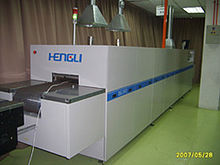User:Khalid hassani/Conveyor belt
This article's tone or style may not reflect the encyclopedic tone used on Wikipedia. (February 2011) |
This article contains instructions, advice, or how-to content. (February 2011) |

A conveyor belt furnace is a
Normally a conveyor furnace adopts tunnel structure and is composed of multiple controlled zones which include, but not limited to, preheating zone, binder burn out zone, heating zone, firing zone and cooling zone. A conveyor furnace also features fast thermal responses, uniform and stable
Schematics

- 1 Pre-heating section
- 2 Binder burn out section
- 3 Heating section
- 4 Firing section
- 5 Cooling section
Process Applications
Thick Film Processing
After a paste is screened onto a substrate and it settles for 5–15 minutes at room temperature, it undergoes oven drying at 100-150°C for 10–15 minutes to remove solvents. Firing is then completed in conveyor belt furnaces at temperatures between 500-1000°C.
Crystalline Silicon Solar Cell Manufacturing
Thin Film Solar Cells Manufacturing
A transparent conducting glass, coated with doped SnO2 or ITO film, is used as a substrate. A thin film, such as CdS, is then deposited through CSS or CBD techniques. The CdS film is heat treated by a conveyor belt furnace in a reducing atmosphere or in the presence of CdCl2 at 400-500°C.
Dye Sensitized Solar Cells (DSSC) Manufacturing
TiO2 nanoparticles have been used extensively to increase the interfacial surface area in Dye Sensitized Solar Cells. Nanoparticle films are generally made by screen printing a paste of titania nanocrystals and then sintering the particles together at 450-500°C in a conveyor belt furnace.
Category:Industrial furnaces Category:Industrial processes
- http://www.finishing.com/Library/pennisi/powder.html What is powder coating, à intégrer également dans powder caoting.
